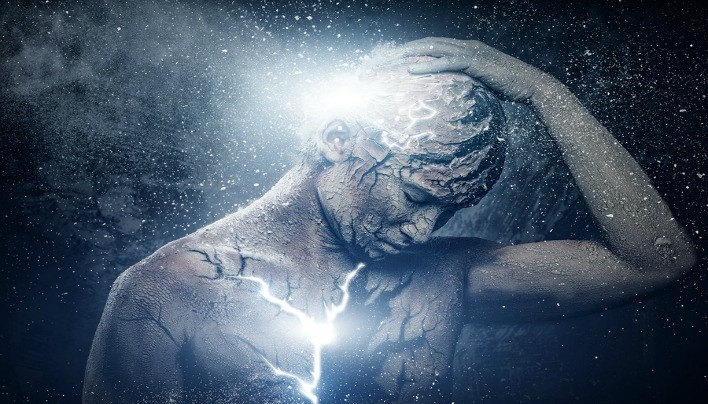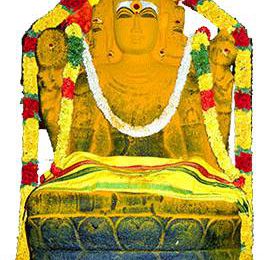“Our science – Greek science – is based on objectification. But I do believe that this is precisely the point where our present way of thinking does need to be amended, perhaps by a bit of blood-transfusion from Eastern thought.”
– Erwin Schrödinger.
The vast area of philosophical enquery known as epistemology is an enquery into knowledge and many authors also call it as the theory of knowledge. In scientific approach to knowledge, an empirical logic based on experiments, observations and inferences is fundamental. In Vedanta this process is called aroha-pantha or jnana marga, ascending path/process or the bottom-up process. But this process has its own limitations.
This scientific process can, at the most, indicate about the existence of God. It cannot lead to the deeper knowledge of God. This is because of the fact that our senses have four inherent limitations. Hence, scientific knowledge based on one’s intellect and sense perception is incomplete and the spiritual knowledge provides the deeper knowledge for the existence of God.
Vedanta recognizes the scriptures as the authority and the deciding factor for the complete knowledge of God. Just like the words of the mother are the authority in regard to our question about the true identity of the father, similarly, according to Vedanta the scriptures are the authority for the proof of God’s existence. This Vedantic process is called avaroha-pantha in sanskrit language. This means that real knowledge should be received by the parampara, descending process or top-down approach.
In nutshell, Vedantic epistemology stresses the acquisition of knowledge mainly from three different ways: pratyaksa (sense perception), anumana (inference) and sabda (revealed knowledge). As it will be evident below,
the Vedantic epistemology justifies the necessity for a synthesis of avaroha-pantha – the top-down process and aroha-pantha – the bottom-up or scientific approach to the complete knowledge of God.
Pratyaksa (direct perception):
According to Vedanta, knowledge gained directly with the help of the senses is known as pratyaksa. The gross senses are the eyes (vision), ears (sound), nose (smell), skin (touch) and tongue (taste). In addition, mind is regarded as the subtle and sixth sense and one can also acquire knowledge with the help of the mind.
The role of pratyaksa is certainly important in acquiring knowledge in Vedantic approach. However, because of the physical limitations of the senses, knowledge gained through pratyaksa may not be complete.
Anumana (inference):
Although the sense capability of ordinary human beings is limited, the quest for scientific knowledge in Vedantic tradition is to know the absolute reality which is beyond the domain of material senses. Anumana means inference about an unknown object based on its relationship with another object that is conceivable through the senses.
For example, a stream of alpha particles which have electric charge would leave a trail of ions as it passes through the gas in a cloud chamber. When water vapor condenses on these ions, the track of alpha particle becomes visible as a line of water droplets. Thus, although we can’t see the alpha particles, we can infer them from the trail of water droplets condensed on the ions. Anumana involves logic.
Logic constitutes the development of a set of arguments that can represent an observed phenomenon in nature.Since the sense perception is limited, therefore, logic, also has limitations and cannot be referred to be the absolute answer for an observed phenomenon.
Limitations of Pratyaksa and Anumana:
As stated before there are four limitations of the senses. as follows:
(a) Bhrama: The senses including the mind often malfunction under various circumstances and are thus illusioned, for example, a mirage seen in the deserts.
(b) Pramada: This means that the senses may misguide a person and he is liable to commit mistakes. Due to the limitations in our intellectual conception we sometimes wrongly interpret the sense observations.Therefore, in this world everyone is liable to commit mistake. Thus the popular saying,
“To error is human.”
(c) Karanapatava: It means that our senses are very limited and can
perceive only a very limited portion of reality. For example, we do not hear sounds which have frequency below 20 Hertz and over 20,000 Hertz. Similarly, we cannot detect electromagnetic radiations in the ultra-violet or infra-red range.
(d) Vipralipsa: It refers to the cheating propensity. Honesty is the virtue of human life. However, sometimes one is overcome by pride, false ego and arrogance and one’s senses are polluted by the lower material modes of nature and one becomes dishonest.
Logic cannot provide a final proof of anything. This is further supported by the statement – one should not use logic to understand what is inconceivable. (Mahabharata, Bhisma Parva 5.22).
Hence it can be concluded that a scientific and logical study may always be incomplete.
Can’t believe.? Okay , do you know,
An argument is the famous Gödel’s Incompleteness Theorem. This theorem states that if ‘A’ is a mathematical system which involves the natural numbers 0,1,2,3,…then there are questions in ‘A’ which cannot be answered using the axioms of ‘A’. In order to answer a question of this kind, one could expand the set of axioms by adding a new one. But the new system will again be subject to Gödel’s theorem and there will be another questions that cannot be answered. Thus, Gödel’s theorem ensures that there will always remain unanswered questions. In other words, scientific knowledge will always remain incomplete and cannot discover the depths of Ultimate Reality or Paramatma (God).
Hence, we should seriously consider the role of metaphysical conception beyond logic and sense perception in understanding transcendental knowledge and God.
In this regard, Max Planck stated, “… the fundamental and indispensable postulates of every genuinely
productive science are not based on pure logic but rather on the metaphysical hypothesis – which no rules of logic can refute – there exists an outer world which is entirely independent of ourselves. It is only through the immediate dictate of our consciousness that we know that this world exists.”
(Max Planck, Where Science is Going?, 1932, p. 138.)
Sabda (Revealed Knowledge) and the Top-Down Process:
In Vedantic ideology “sabda” is the most important in receiving a valid knowledge and the other two epistemic elements, pratyaksa and anumana are to assist the sabda pramana. A revealed knowledge is transmitted from the Supreme Authority, God, to the bonafide and sincere recipients. The qualification of the recipient is that he should be a completely surrendered soul to the Supreme Lord,
As mentioned earlier this process is also called a top down approach in receiving knowledge (avaroha-pantha).
A simple example is to make an investigation about the true answer to the question, “Who is the father of child A…??”
In a scientific or the bottom-up process, one can make an extensive research work by matching the DNA profile of several candidates with that of the child. However, it will be extremely difficult to find a real answer by this process. Most likely, needless to say, a real answer may never be found by this approach. This is because the real person may not be tested for a variety of causes. So, the easiest and most reliable approach will be to simply ask the genuine mother, and her answer will be the final verdict.
The fact is that a genuine mother will never tell a lie to her loving child. If somebody wants to confirm this answer scientifically, a DNA test can still be done. In this way, the matter is resolved. This process implies a genuine faith the child has in the words of the mother. According to Vedanta, this genuine faith is a deep spiritual quality of life.
God is the ultimate source of everything, and the divine consciousness flows downward from God to every living being. In scientific discoveries and other artistic and poetic works and spiritual works of total sacrifice and renunciation, many sincere individuals receive knowledge through inspiration from a guiding source. This type of knowledge can also be regarded as some kind of revealed knowledge. In this way, knowledge is also directly transmitted by the Supreme Authority to the sincere seekers of truth.
Lord Sri Krisna states in the Bhagavadgita (15.5):
“sarvasya caham hridi sannivisto
mattah smritir jnanam apohanam ca!
vedais ca sarvair aham eva vedyo
vedanta-krid veda-vid eva caham!!”
“I am seated in everyone’s heart, and from Me come remembrance, knowledge, and forgetfulness. By all the Vedas, I am to be known. Indeed, I am the compiler of Vedanta, and I am the knower of the Vedas.”
There are three fundamental principles in realizing the revealed knowledge. Firstly, every revealed knowledge should be accepted as a divine axiom. All the aphorisms of the Vedantasutra can be regarded as divine axioms. Secondly, the genuine scriptures should be understood as they are and they should not be interpreted in any way to suit the motives of any particular individual or group.
The author would like to mention that it is because of the misinterpretation of scriptures and over-intoxication by the materialistic concept of religion that people kill each other in the name of religion and God.



